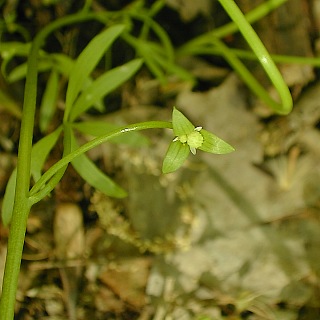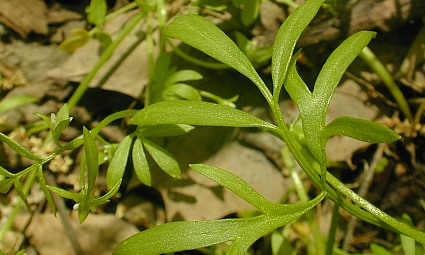Description:
This
annual plant is up to 1' long and sparingly branched. Its
slender stems are glabrous and sprawling to erect. The alternate leaves
are up to 3" long and 2" across; they are pinnately compound with 3-7
narrow leaflets. Each leaflet is linear-oblong, smooth along the
margins, and hairless. Occasionally, a leaflet may be cleft into 2-3 narrow lobes. Both the
stems and leaves are light green and rather mossy in appearance.
Individual flowers develop from the axils of the upper leaves. Each
flower is about ¼" across, consisting of 3 green sepals, 3 white
petals, 6 stamens (usually), and a single style. The sepals are
lanceolate-ovate and much larger than the petals. The petals are
narrowly oblong and inconspicuous. The slender pedicel of each flower
is about 1" long. The blooming period occurs from mid- to late spring
and lasts about a month. During the heat of summer, the foliage turns
yellow and quickly withers away. Each flower develops 1-3 carpels that
are globoid and bumpy across the upper surface. The carpels are
initially pale green or pale yellow, but they later turn brown and
release the seeds. The root system consists of a slender branching
taproot. This plant spreads by reseeding itself, and it often form
colonies at favorable sites.
Occasionally, a leaflet may be cleft into 2-3 narrow lobes. Both the
stems and leaves are light green and rather mossy in appearance.
Individual flowers develop from the axils of the upper leaves. Each
flower is about ¼" across, consisting of 3 green sepals, 3 white
petals, 6 stamens (usually), and a single style. The sepals are
lanceolate-ovate and much larger than the petals. The petals are
narrowly oblong and inconspicuous. The slender pedicel of each flower
is about 1" long. The blooming period occurs from mid- to late spring
and lasts about a month. During the heat of summer, the foliage turns
yellow and quickly withers away. Each flower develops 1-3 carpels that
are globoid and bumpy across the upper surface. The carpels are
initially pale green or pale yellow, but they later turn brown and
release the seeds. The root system consists of a slender branching
taproot. This plant spreads by reseeding itself, and it often form
colonies at favorable sites.
Cultivation:
The preference is diffuse sunlight to light shade during the spring
when vegetative growth and development occurs, otherwise it can be
quite shady. The soil should be consistently moist and loamy or silty.
This plant doesn't like to dry out.
Range & Habitat:
The native False Mermaid occurs occasionally in northern and east
central
Illinois, otherwise it is rare or absent (see Distribution
Map). Habitats include moist to mesic deciduous woodlands and
low-lying areas along springs and small rivers in wooded areas. False
Mermaid is usually found in high quality woodlands where the original
flora is still intact. This is one of the spring wildflowers in
woodlands that is threatened by the invasion of Alliaria
petiolata (Garlic Mustard).
Faunal Associations:
The small inconspicuous flowers can attract flower flies and small
bees. The foliage is not known to be toxic and may be edible to
mammalian herbivores, although little is known about floral-faunal
relationships for this species.
Photographic
Location:
A moist area of Busey Woods in Urbana, Illinois.

Comments: This inconspicuous little plant is easy to overlook, except where it occurs in sizable colonies along the woodland floor. The delicate foliage is attractive and resembles moss or a Galium sp. (Bedstraw). It isn't immediately obvious when False Mermaid is blooming as the flowers are inconspicuous – careful inspection at the right time during the spring will reveal the green sepals, tiny white petals, and the stamens. It is fairly easy to identify this plant because each flower has only 3 sepals and 3 petals, while the alternate leaves are pinnately compound. Other woodland plants with a similar appearance include Galium spp. (Bedstraws) and Ellisia nyctelea (Aunt Lucy). Bedstraws have flowers with 4 petals and their simple leaves occur in whorls. Aunt Lucy has pinnately compound leaves, but its flowers have 5 white petals and its foliage is more or less hairy.